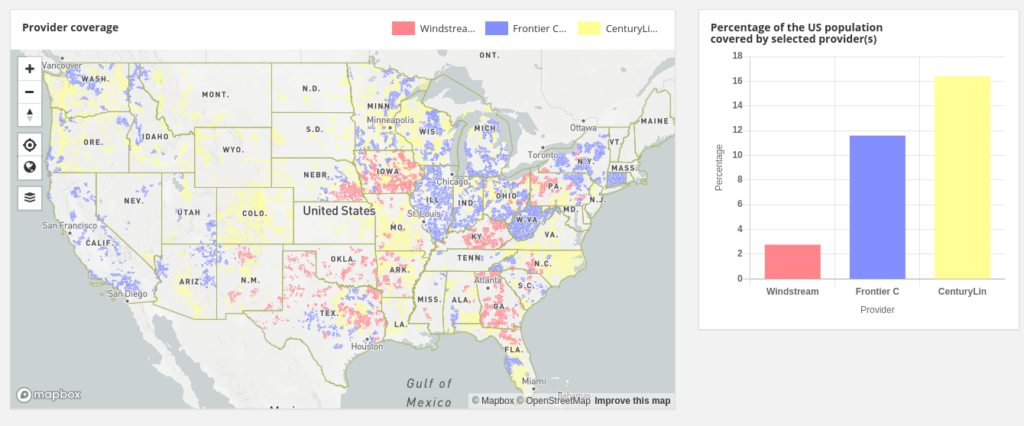 During the last two weeks, most of the nation’s large internet service providers have responded to the COVID-19 emergency by launching free or very low-cost rate plans, designed to help more residents get and stay on line in order to cope with the sudden new demands of home isolation. While these new offerings vary in significant ways — who’s eligible, short-term vs.longer-term discounts, connection speeds, etc. — they all reduce the cost barrier to digital inclusion for large numbers of unconnected households, at a time when those households need it most.
During the last two weeks, most of the nation’s large internet service providers have responded to the COVID-19 emergency by launching free or very low-cost rate plans, designed to help more residents get and stay on line in order to cope with the sudden new demands of home isolation. While these new offerings vary in significant ways — who’s eligible, short-term vs.longer-term discounts, connection speeds, etc. — they all reduce the cost barrier to digital inclusion for large numbers of unconnected households, at a time when those households need it most.
NDIA’s list of Free and Low-Cost Internet Plans now includes special offerings from ten of the nation’s sixteen biggest home internet providers. Seven are cable broadband providers (Comcast, Charter, Cox, Altice, Mediacom, Sparklight and Atlantic Broadband). The other three are telco (DSL/fiber) providers: The biggest, AT&T, plus two much smaller companies — Consolidated Communications and TDS.
In 2019 these “providers with plans” accounted for more than 95% of all U.S. cable broadband households… but only about half of households with DSL or fiber Internet.
Why such a disparity? Unfortunately, five of the eight major telco providers — including the second, third, fourth and fifth biggest — have not yet stepped up with free or low-cost rate plans to help households in need get connected during the crisis.
Verizon. The second biggest telco ISP, Verizon, has responded to the crisis by waiving all charges for its current Lifeline customers for two months, including charges for FIOS broadband (i.e. fiber Internet service) if that’s where the customer has chosen to apply the household’s monthly Lifeline subsidy. This will certainly help that particular group of existing Verizon Internet customers. Unfortunately it’s a very small group.
For new Lifeline-qualified (i.e. low income) customers, Verizon is offering a $20 monthly discount on home broadband. But it’s only available for FIOS fiber-to-the-home service, not for DSL. This leaves out the otherwise eligible households in large parts of Verizon’s service area where FIOS has not been deployed, including the entire cities of Buffalo and Baltimore. And it means those who take advantage of the offer will still see Verizon Internet bills totalling more than $20 a month.
So Verizon is not on our Free and Low-Cost Internet Plans list. But to be fair, Verizon has at least made an effort to respond to the critical need to lower the cost barrier for new broadband users.
Unfortunately the same can’t be said for the next three largest telco ISPs — Century Link, Frontier, and Windstream.
Century Link, Frontier, and Windstream. These three companies are the main (or only) providers of DSL and fiber Internet service for more than nine million households spread across 45 states. A large number of those households are in rural and “micropolitan” areas of states where AT&T or Verizon are the dominant urban providers. But Century Link is also the incumbent telco for some big cities and their suburbs, including Phoenix, Denver, Portland (OR), Seattle, Las Vegas and Minneapolis-St. Paul (among others). And Frontier’s territory includes almost the entire states of Connecticut and West Virginia, including Hartford and Charleston; it also includes Rochester (NY).
Here’s a screenshot of the FCC’s map of the Century Link, Frontier, and Windstream broadband service areas. At this time, the shaded areas do not have a Free or Low-Cost Internet Plan from their DSL/fiber Internet providers to help make sure all residents can get on line during the COVID-19 crisis.
Cincinnati Bell. The eighth biggest telco Internet provider in the U.S. is Cincinnati Bell, with about 425,000 households in greater Cincinnati (Ohio and Kentucky) as well as parts of Hawaii including Honolulu. At this time, Cincinnati Bell has no Free or Low-Cost Internet Plan to help residents of its service areas deal with the COVID-19 crisis.
There are hundred of smaller Internet providers across the U.S., some of which are offering reduced rate options during the crisis, and some of which aren’t. But NDIA believes that the major cable and telco providers have a special responsibility to help reduce the gaps in Internet access in the communities they serve — at a time when those gaps represent a serious threat to life, health and public safety for millions of Americans.
It’s heartening to see the majority of big providers taking that responsibility seriously. We encourage those who haven’t stepped up yet to do so very soon.

